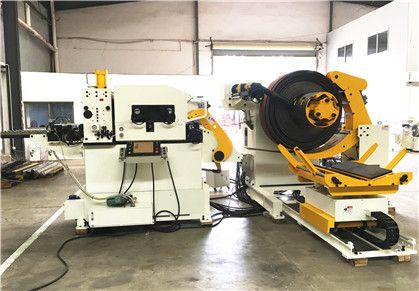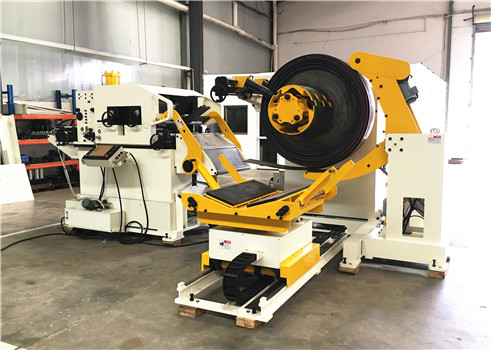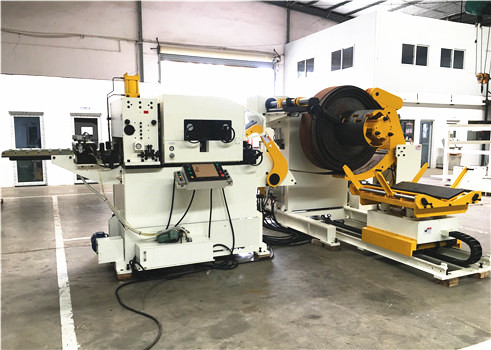SUNRUI Coil Feed Line---Specifying a Coil Handling & Feeding Line

The SUNRUI coil feed line is includes a decoiler, a straightener, a feeder, and a control system.
The SUNRUI coil feed line is known for its high precision, speed, and efficiency during the metal processing process. It is often used in various industries such as automotive, electronics, and construction due to its versatility.
The SUNRUI coil feed line is also customizable to meet specific requirements, making it a popular solution for customized production needs.
The coil feed line is an automated production system that is used to handle metal coils and strips. It involves a series of equipment that is designed to efficiently feed metal coils into stamping presses. Coil feed lines are used in a variety of industries that require precision cutting, forming, or stamping of metal sheets. The metal coils are unwound from their storage position using a decoiler, and then straightened using a straightener to meet the desired specifications for the product being manufactured. The straightened metal then enters a feeder, which then positions the metal into the press. With the pressing of a button, the metal is then cut, formed, or stamped into the desired component ready for further processing.
The feeding process is facilitated by the use of rollers and other feeding mechanisms, which are precisely adjusted to ensure that the metal is fed into the press in a consistent manner. The speed of the feed line can also be adjusted depending on the production requirements.
Overall, the coil feed line is an excellent solution for manufacturers that require high-volume production of products with tight tolerances. By automating the feeder process, manufacturers can improve their production efficiency, reduce material waste and errors, and optimize finished product quality. The coil feed line with a decoiler, straightener, and feeder is a type of automatic production line that handles metal coils and strips. The components that typically make up the production line include:
1. Decoiler: The decoiler is responsible for unwinding the metal coil from its designated position and keeping it level during the production process.
2. Straightener: The straightener performs a leveling function on the metal strips to ensure that they meet the desired specifications for the product being produced.
3. Feeder: The feeder is responsible for precisely and accurately feeding the metal strips into the stamping press at a consistent rate.
All three of these components working together make up a complete coil feed line. Coil feed lines are widely used in the manufacturing of metal hardware products that require high-precision stamping, including electronic connectors, switches, terminal blocks, and other similar products. The use of coil feed lines can improve production efficiency, increase output, and reduce costs, making them an essential part of the manufacturing process for various industries.


How To Build A Coil Feed Line?
Designing and building a suitable coil feed line requires consideration of several factors, including the type of material to be used, the desired output requirements, the available space, and other operational needs. Here are some basic steps that can guide you in building a suitable coil feed line:
Choose the right equipment: Select a decoiler, straightener, and feeder that are suitable for the type of material to be processed, the desired output requirements, and other operational needs. Make sure the equipment you select can handle the width and thickness of the metal coils you will be working with.
Determine space requirements: Determine the available floor space for the coil feed line and design a layout plan that optimizes the use of the space. This includes space for the equipment, the material handling system, and other safety measures.
Optimize the Material Handling System: Select a material handling system that can effectively move the material from the decoiler to the straightener to the feeder and then to the press. This could involve using conveyors, lifters,carts, or other types of equipment.
Ensure operator safety: Equip the coil feed line with necessary safety measures such as guards, alarms, and safety switches to protect operators from harm.
Test and Adjust the Feed Line: Once the coil feed line is built, conduct testing and adjustments to ensure it is working efficiently. Make any necessary changes so that it can handle the desired metal coil widths, thicknesses, and material feed rates.
In summary, building a suitable coil feed line involves selecting the right equipment, optimizing the material handling system, ensuring operator safety, and testing and adjusting the system to ensure optimal performance. Hiring an expert in the field to assist you throughout the process can be instrumental in achieving the desired result.
Why Recommend SUNRUI Coil Feed Line?
SUNRUI coil feed line is recommended for several reasons, including:
Increased Efficiency: Coil feed lines eliminate the need manual of metal strips or sheets, and automate process of cutting and feeding metal strips into a stamping press. This increases the efficiency of the production process and reduces the overall time taken to manufacture products.
Consistent Quality: Coil feed lines can deliver consistent quality products, even at high production rates. As each component of the feed line is designed to precisely handle the material, the finished product is produced within the required tolerances.
Reduces Material Waste: Because the feed line produces consistently sized materials, there is no need for excess metal to be cut off, thus minimizing waste and reducing the production cost.
Safe Working Conditions: The use of a coil feed line can also improve workplace safety, by eliminating tasks that are more hazardous and, in part, automating the production process.
Cost-Effective: Despite the initial cost required to install a coil feed line, it can generate long term benefits from optimizing material yield, reduced labor costs, increased product quality, and production efficiency.
For these reasons, a coil feed line has become widely used in the manufacturing of various metal hardware products, including electronic components, switches, terminal blocks, and other related sheet metal parts. They help to optimize the production process, reduce costs, minimize operator risk, and improve finished product quality, making it a viable investment to meet different manufacturing needs


